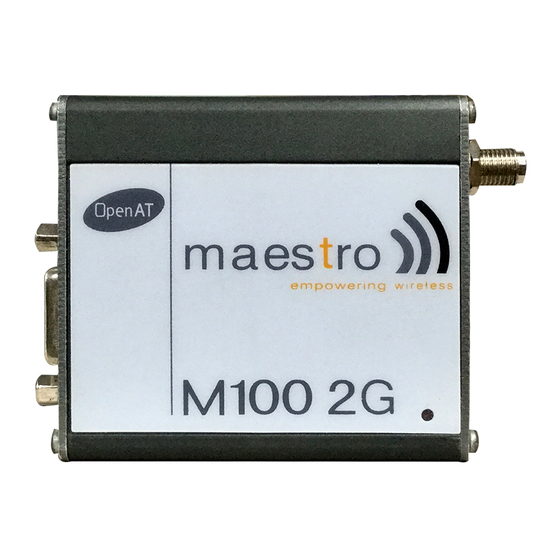Summary of Contents for Maestro 100 Series
- Page 1 Maestro 100 Series GSM/GPRS Modems Eco – Lite – 100M – Extended USER MANUAL Rev. 01...
-
Page 2: Revision History
Cecile Lin This manual is written without any warranty. Maestro Wireless Solution Ltd. reserves the right to modify or improve the product and its accessories which can also be withdrawn without prior notice. Besides, our company stresses the fact that the performance of the product as well as accessories depends not only on the proper conditions of use, but also on the environment around the places of use. -
Page 3: Table Of Contents
3. The modem does not respond to the terminal program ... 15 4. No voice could be heard for the modem’s speaker output when a call is answered ..................15 Confidential, the whole present document is the sole property of Maestro Wireless Solution Limited. www.dayTelecom.com... -
Page 4: Safety Precautions
SAFETY PRECAUTIONS The modem generates radio frequency (RF) power. When using the modem care must be taken on safety issues related to RF interference as well as regulations of RF equipment. Do not use your phone in aircraft, hospitals, petrol stations or in places where using GSM products is prohibited. -
Page 5: Chapter 1: Introduction
It also supports GPRS Class 10 for hi-speed data transfer (except Maestro 100 Eco). Maestro 100 can be easily controlled by using AT command for all kinds of operations. With standard 9-pin RS232 port and telephone-like audio plug (via optional cable) the Maestro 100 can be set up with minimal effort. -
Page 6: 15-Pin D-Sub Female Connector (Rs232/Audio)
Specification of microphone and speaker to be connected: Parameters Typical Max Remark Microphone current @2V/2K Ohm 0.5mA Microphone input level 100 mVpp Speaker output current 150 Ohm/1nF 16mA Speaker impedance 32ohm 50Ohm Please refer to the document "Application notes - Power supply & Audio" for more information about audio connection. -
Page 7: Optional Accessories
A cable, included in the package shall be used for power supply connection: 5-32V DC Supply Stripped wire Fuse holder Connector Micro-Fit 3.0 Fuse rating: 250V – 2.5A 3. Optional accessories You may contact your sales agent for the following optional accessories: External antenna - Magnetic mount type - Frequency GSM 900/1800 band... - Page 8 Pin assignment Sub-D 15 (male) Sub-D 9 (female) Plug 4P4C DIN rail mount Quick attachment / detachment to standard DIN rail Zinc plated Steel www.dayTelecom.com...
-
Page 9: Chapter 2: Installation
CHAPTER 2: INSTALLATION 1. Mounting the modem Use 2 pieces of M3 screw to mount the modem. When using optional DIN rail mount, please refer to document "Installation of DIN rail mount". Screw mounting slot Bottom view 2. Install the SIM card Use a ball pen or paper clip to press the SIM holder eject button. -
Page 10: Connect The Modem To External Device
'LINE' jack of a landline telephone. Connection example using optional 'Y' cable: 4p4c plug Handset of phone Sub-D 15 pin Maestro DB-9 connector connector RS-232 port of PC 5. Connect the DC power supply Connect the open ending of the inducted power cord to a DC supply. Refer to the following for power supply requirement. -
Page 11: Chapter 3: Working With Maestro 100
CHAPTER 3: WORKING WITH MAESTRO 100 1. Checking the modem (using Microsoft Windows XP HyperTerminal as example) a. On the first time power-up you can use terminal software to communicate with the modem through an RS232 serial port. Following example is using the HyperTerminal in Windows XP. - Page 12 c. Choose the correct Com port and baud rate settings (9600bps for Eco; 115200bps for others, 8bits, no parity bit, 1 stop bit) d. On the terminal screen, type "AT" to check the "OK" response from the modem www.dayTelecom.com...
-
Page 13: Basic Operation
2. Basic operation Followings are examples of some AT commands. Please refer to the AT command document for a full description. Note: Issue AT+CMEE=1 to have extended error code (+CME ERROR) Modem Description AT commands Comments response Network AT+CREG? CREG=<mode>,1 Modem registered to the registration network... -
Page 14: Chapter 4: Specifications
Group 3 FAX support (Class 1 and 2) GPRS Class B class 10 (4Rx+1Tx or 3Rx+2Tx) at maximum speed* (not applicable for Maestro 100 Eco) SIM Tool Kit Class 2 AT command set (GSM 07.05, GSM 07.07 and WAVECOM proprietary) *Note: available slot for GPRS connection is network dependent. -
Page 15: Chapter 5: Appendix
CHAPTER 5: APPENDIX 1. Factory settings The modem has the following factory settings. Please refer to the AT command document for the meaning of each setting. Related AT commands Factory settings Description AT+IPR 115200 (9600 for Eco) DTE-DCE data rate AT+IFC DTE-DCE flow control AT+ICF... -
Page 16: Chapter 6: Troubleshooting
3. The modem does not respond to the terminal program Check if the RS232 cable has been properly connected Check if your program has proper settings. Factory setting of the modem is: 115200 (9600bps for Maestro 100 Eco) 8 data bits No parity bit 1 stop bit 4.







